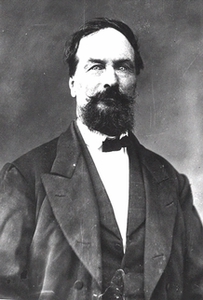HICKMAN, WILLIAM ADAMS

William A. Hickman
William Adams Hickman was born 16 April 1815 in Warren County, Kentucky. He moved with his parents to the Missouri Territory when he was four years old, two years before Missouri statehood.
Indians and wild animals were a part of the settlers' daily life on the frontier, while guns and fists settled most disputes. This rugged boyhood influenced Hickman throughout his lifetime of sixty-eight years. He died in August 1883 in a dugout on America's last frontier near Lander, Wyoming. Known as the "Notorious" or the "Danite Chief" of Utah, Hickman did not consider himself an outlaw, but rather an appointed lawman or soldier in the Mormon militia.
He first married in Missouri in 1832 when he was barely seventeen years of age. By 1858 he had married nine more wives in polygamy; all but the first marriage were performed by or sanctioned by Brigham Young. He was father to thirty-five children; few Mormon men had a larger family.
Shortly after his first marriage, he met Mormons from Ohio as they passed by his farm on their way to Jackson County, Missouri. He talked to them, fed many, and ended up a convert to Mormonism in 1838. After the expulsion of the Mormons from Missouri he moved to Illinois.
At the close of the Nauvoo period in September 1846, Hickman showed his fighting spirit by being one of the last 100 defenders of the beleaguered city, using only a home-made cannon for defense until the city's residents could be evacuated.
At Winter Quarters, Brigham Young appointed Hickman as a lawman. His assignment included a charge to protect Orson Hyde, a church apostle and the political and civic leader of what became a large 20,000-member community.
Green River County, organized by the Utah legislature in 1852, was staffed in 1854 by Brigham Young's appointees. Hickman was sheriff, tax collector, tax assessor, assistant federal marshal, and the first legislator to represent the county. During this period, besides maintaining a semblance of law and order, he negotiated, perhaps by force, the sale of Fort Bridger to the Mormons in August 1855, for $8,000.
In February 1857 Hickman carried the mail east to Independence, Missouri, for the B.Y. Express Company. He made the round trip, returning in haste to the territory to report to Brigham Young on 24 June 1857 that the U.S. Army was coming to Utah to take over the local government. Brigham Young kept this report confidential until a month later when it was dramatically confirmed by the arrival of Orrin Porter Rockwell at the 24 July picnic.
The Utah War of 1857-58 resulted in all able-bodied Mormon men taking part in the defense of the territory. Hickman served heroically, mainly in Green River County, where he helped destroy army wagon trains; later, on the night of 7 October, he burned Fort Bridger. Ten days later he executed an enemy spy named Richard Yates.
Later, with the establishment of Camp Floyd, Hickman and his gang, later called "the Hickman Hounds," found a livelihood as well as excitement in pillaging the army's livestock. Hickman felt justified in these activities because of an earlier oath he had taken to defend the Mormons against all enemies; and his actions were defended by church leader Orson Hyde.
A gunfight on Christmas Day 1859 in downtown Salt Lake City nearly ended Hickman's life. He was shot in the hip by his long-time friend and protégé, Lott Huntington in an argument over stolen horses. The effects of this wound plagued Hickman throughout the last 22 years of his life and caused him to walk with "a shuffling gait."
From 1863 to 1865 Hickman was an "Army guide and Indian Spy" for the U.S. government, serving under the direction of General Patrick Connor. His friendship with General Connor led to Hickman's involvement in the first mining venture in the territory, in Bingham Canyon, and later in other ventures in Wyoming. His friendship with Connor also helped cause his estrangement from Brigham Young.
On 12 June 1868, while Hickman was on a visit to California, he was excommunicated from the Mormon Church by his Taylorsville bishop. All but his first wife left him when his practice of polygamy no longer came under the protection of the church.
In September 1870 Hickman, no longer a lawman, shot and killed a man in Tooele County who had threatened his family. He was indicted for murder, which charge was dismissed by an arrangement proposed by Third District Court Judge James B. McKean, a well known anti-Mormon. The conditions of Hickman's exoneration included an appearance before a grand jury where he would tell all he knew about the death of Richard Yates during the Utah War. Hickman's testimony before the grand jury brought indictments for murder against Brigham Young and several other prominent church leaders. All were jailed at Fort Douglas except Brigham Young, who was placed under "house arrest".
During this period Hickman was encouraged by anti-Mormons to write his autobiography, Brigham's Destroying Angel, published in New York City in January 1872. For decades, people believed this was Hickman's true story, when all it did was exaggerate the bad he did and eliminate the good he had done for the territory. The manuscript was extensively edited by J.H. Beadle.
In June 1880, sick and persecuted, Hickman left Utah with a few family members to live in the wilderness of the Wind River Mountains in western Wyoming, where he died in August 1883.
Disclaimer: Information on this site was converted from a hard cover book published by University of Utah Press in 1994. Any errors should be directed towards the University of Utah Press.